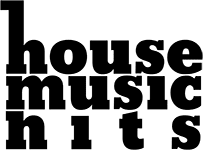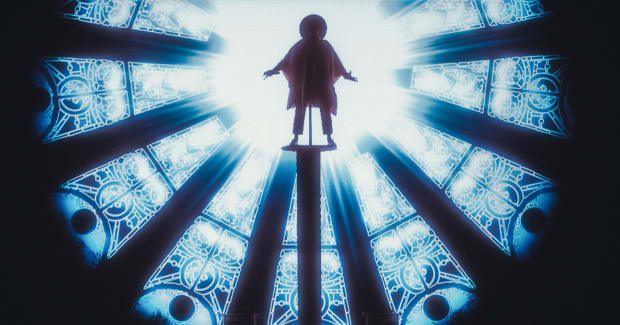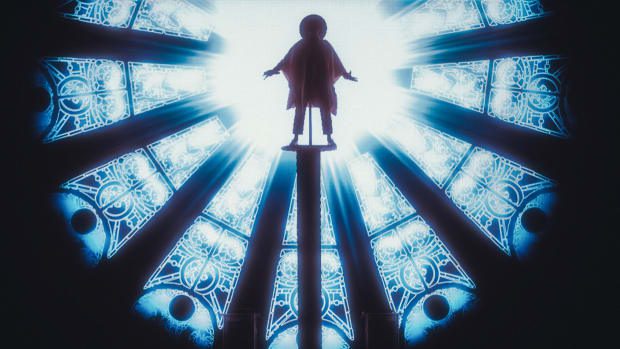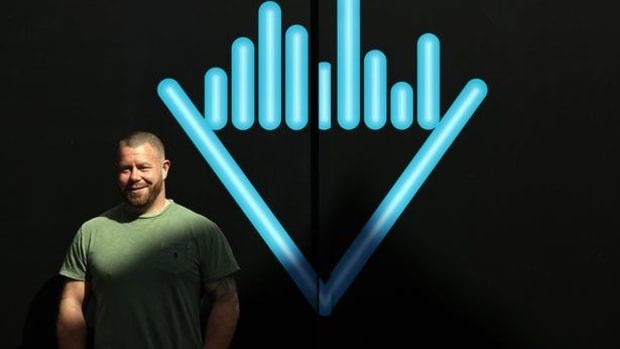They say ideas grow better when transplanted into another mind—and Madeon has four of them.
The French electronic music virtuoso, whose real name is Hugo Leclercq, is currently on his "Good Faith Forever" tour, where he's been baffling ravers with a new, pupil-popping stage production. But just like any groundbreaking show, there's more to it than meets the eye.
Four visual artists, Shinichiro Fujita, OSEAN, Mollie Tarlow and Mike Kluge, function as the brainstem of "Good Faith Forever" as well as its illusory encore, which finds Madeon lifted atop a giant cylindrical structure as his silhouette morphs into the tour's phantasmagoric imagery. Their cerebral work, Leclercq says, has shaped not only the tour, but also his own creative development.
You can learn a lot about someone by their usage of the pronouns "we" and "I." Effusive in his praise of the small team of prolific architects, Leclercq rarely uses the latter.
“When we make the visuals for the show, it’s not like I'm 'the client' or 'the artist' and they have to do as I say. No—we’re all in the same place, in the same room, at the same level, all on our computers, working together and with the same vision," Leclercq tells EDM.com in a Zoom interview. "And at the end of the day, my main mission is to be the captain of the ship and to make sure it gets in the right direction, but what makes it magical is that we all have a lot of respect for each other and really value what everybody’s unique perspective contributes.”
"It's not just a gig," he continues. "It's our passion."
Hellbent on breathing life into the Madeon mythos, the team's cardinal conviction is dyed in the wool: nobody can get there unless everybody gets there.
"What this group is capable of together is limitless because of Hugo," Tarlow says. "He explores beyond the bounds of even his own visions in the pursuit of possibility and in that ethos created an environment designed to bring out the best in all of us."
Leclercq's involvement in the innovative "Good Faith Forever" production extends far beyond the confines of its ideation, which he says began back in 2015. While most artists outsource the labor to a battalion of creatives, he saw the show as an opportunity to hone his skills in visual conceptualization, graphic design, animation and even font creation.
"They all found a home in this show," Leclercq gushes. "It's so creatively fulfilling."
So he mocked up the first-ever sketch of the ambitious lift concept before watching it come to life years later. And it's uncanny.
However, the journey from mockup to marvel wasn't easy. In order to make the dream a reality, Leclercq and his team connected more times than breakups and ice cream.
Early on, Leclercq knew he wanted his silhouette to be the nucleus of the "Good Faith Forever" show, working in lockstep with the kaleidoscopic visuals that unfold around him. He just didn't know how.
So he purchased a Ken doll—yes, of the Barbie variety—to use as a barometer. After loading the tour's sublime visuals onto a proportional TV, he held the figurine in front of the screen to get a feel for the scope of his silhouette when enveloped by the show's immersive production.
Eventually Fujita, OSEAN, Tarlow, Kluge and Leclercq formulated what the latter calls a "secret bible of techniques," a blanket phrase for their sophisticated approach to interpolating darkness, vanishing points and other visual elements into a cohesive latticework. They then worked to implement it with help of Gordon Droitcour and Erik Anderson, cofounders of Cour Design and Cour Content, the companies that helped produce the "Good Faith Live" and "Good Faith Forever" tours.
The "secret bible" dictates the technical direction of "Good Faith Forever," but its substance derives straight from the mind of Leclercq, who says he's able to conjure obscure imagery from movies, paintings and even abstract childhood memories. He and his team then work to manifest those references in the show, which he says has "its own lore and story."
"We spent a lot of energy collectively creating this encyclopedia that reveals a lot more about the secret world and meaning of the show," explains Leclercq, who calls the compendium The CODEX. "The world was also clear to me already, to be honest, from the start. There’s always been this underlying 'Good Faith' meaning and story that is very, very clear to me. I try to reveal it progressively and slowly."
The show's core motif, however, is the human body. Leclercq explains that he's particularly fascinated by the theme of cloning, which is represented in one of the tour's most breathtaking sequences.
"The main inspiration was that I wanted to create a show that was electronic, but I was more embodied," Leclercq explains. "I found that a lot of the electronic shows I liked involved the artists kind of hiding within a larger structure. And I just wanted to be unobstructed, to be in front of people, more as a frontman than as a DJ."
Electronic dance music is associated with sensory overload thanks to pyrotechnics, drone displays and other grandiose theatrics that naturally distract from any given performer's art. Leclercq is challenging that axiom by presenting Madeon as the epicenter of a visual storyline unfolding around him. They're symbiotic.
"I feel like the most straightforward way to be embodied was to make my silhouette a constant presence," continues Leclercq, who considers himself more a "character in a show" than a performing artist. "But the thing I'm sometimes insecure about is I always think about the show more as the director than the performer. So when we make the visuals, I sometimes forget that it's going to be me up there."
But it's his perspective as a "director" that enables him to grow. Leclercq's artistry is existentialist in nature, rooted in the idea that we each have the ability to create our own sense of purpose and peace.
"What I love about this show—and the reason why I’m more proud of if than anything else I’ve ever worked on—is I feel like it's so distinctly the result of my taste and my interests, and my life," he says. "All of my hobbies found my way into this show."
From a technological standpoint, the lift sequence pales in comparison to the resplendent displays of, say, a pop star on a stadium tour. But that doesn't make it any less epic, especially for Leclercq, who has battled vertigo in the past and has to be raised to a height of 16 feet in a rave atmosphere akin to pandemonium.
He says the production isn't a technological breakthrough, which speaks volumes about his team's creativity and their conviction when it comes to squeezing every last drop of imagination.
Recommended Articles
How Madeon and a Team of Architects Designed the Hallucinatory "Good Faith" Experience—And Blew Everyone's Mind
An intimate interview with Madeon, whose intricate "Good Faith Forever" tour production is what happens when teamwork meets triumph.
Watch Nile Rodgers Explain His Introduction to Daft Punk and How "Get Lucky" Came to Be
The legendary Chic guitarist recounts connecting with Daft Punk and the recording process of "Get Lucky."
U.K. Business Owner Converts Old Pharmacy Into "Micro-Club" Experience
Just 60 clubbers can fill the capacity of TROPI's Bar, whose owner believes the "micro-club" is the first of its kind.
"I think we’ve created an image that hopefully people haven’t quite seen—because we dreamt it up rather than the technology being available," he asserts. "I’m not interested in being the first to use a new tool. I want for it to be more of a triumph of our heart rather than the triumph of our wallet."
The tool they use to raise Leclercq up on the cylindrical platform, however, is a great feat of engineering. So is the bespoke safety apparatus, which his team members have to install and append covertly in order to avoid disrupting the show. They then have to attach him to a metallic safety rail using a special belt.
“I could fall to my death. That’s one of the main challenges," Leclercq explains. "But I can’t really fall off the platform—I’d be dangling on the edge. This would obviously never happen since safety is our top priority. I’m actually really deeply attached and I can't move very much. I couldn’t even sit down if I wanted."
Every spec of the production is tailored to his silhouette—even his wardrobe. One of Madeon's signatures is his cloak, which gives him a dark, gallant mien à la V for Vendetta. He uses the cloak to conceal the belt that straps him into the safety device. Another Madeon cornerstone is his discoid fedora, which he says produces a prismatic effect when he turns his head underneath the lights.
However, Leclercq maintains that the most crucial element of the tour is darkness. He says his team—especially Fujita, a brilliant VJ—remains vigilant throughout the show in order to identify and exploit blackout moments, which they can manipulate to further plunge fans into the "Good Faith Forever' rabbit hole.
All of this is done in execution of the architects' end goal: to create vertical images where the cylinder appears to vanish.
After years of conceptualizing the "Good Faith Forever" storyline and concept, the first time Leclercq and his team were able to test out the production was ahead of its debut in D.C.—on the same day of the show. He says they spent a month developing the cylindrical platform concept and were confident in their ability to deliver it.
But the vicissitudes of ambition got in the way.
"We decided to commit and be like, 'Hey, we’re going to invest all this energy into making it, and if we show up at rehearsals and it doesn’t work, we’ll come up with a new idea,'" Leclercq recalls.
At rehearsals, he explains, they couldn’t test the full-size LED screen because of weight restrictions. So they tried it on a smaller scope and saw the concept worked, but the team were still going in blind. When they were finally able to bring in the giant platform, it was the first time Leclercq ever saw it at scale. But it was "only 80% what we imagined," he said.
Fans who attended the "Good Faith Forever" debut in D.C. may be wondering why the doors were delayed 15 minutes. It's because Leclercq was figuring out how to fully realize his vision, tweaking sections of the music at the eleventh hour on his Macbook literally as the doors were supposed to open. He re-rendered the final version of the visuals, handed the file to the media server, and it was off to the races.
The experience was a watershed moment for Leclercq and his plucky team of visual artists, whose resilience set the tone for the rest of the tour. He thinks of that stress test whenever he’s performing the show's dazzling finale sequence, which has now become routine.
But this isn’t your ordinary serotonin rush. There are enough obscure details in the "Good Faith Forever" blueprint to make Le Corbusier bite his nails.
"We’ve created this language that is ours," Leclercq says.
He explains that his team actively tries to avoid thinking about other productions because they don't want to be influenced by them, instead using real-world, shared experiences. One time he even saw a mid-century chair that was engineered with a peculiar design at a strange angle. So they used that angle to frame a visual in the show.
"We always strive to create a truly unique look and end up going to some pretty funky lengths just to get a vision we set out for," says OSEAN, whose speed and eye for composition Tarlow calls "absolutely spectacular."
"I point my personal laser pretty sharply at color-driven image manipulation, but I also love poetry and ancient religions and biology, so a lot of my favorite contributions in the show have come from really obscure old books and curious art. I like a wild jumping-off point," adds Tarlow, who also rhapsodizes about her visual pièce de résistance, the "Nirvana flower."
Now, Leclercq is gearing up for the zenith of the "Good Faith Forever" orbit, the iconic Coachella music and arts festival. He likens his upcoming performance to a knife-edge, a defining moment that will materialize his team's full vision.
"Coachella is a milestone moment for us. We’ve been working towards this forever," Leclercq says. "A lot of the ideas for the show, we could only present at a certain scale on my own tour. But we’ve conceptualized them with Coachella in mind. Coachella will open up the experience and show you the full picture in a way we haven’t been able to before because of the sheer scope of it. I think the images we're going to be able to present are going to be really special."
"For us, it all leads to this moment," he continues. "We want it to be perfect."
As Leclercq continues to build on the metaphysical narrative of his Grammy-nominated Good Faith album, one thing his clear: his relationship with the shackles of reality is more dysfunctional than ever. And that should be celebrated.
Good Faith was akin to a coming-of-age for Leclercq, who had been navigating the thorny thickets of the music industry since the age of 16. The album's core leitmotif was his elusive search for a sense of self when faced with the pressures of conformity. In many ways, the subversive "Good Faith Forever" tour is a microcosm of his detachment from those burdens.
And for an aesthete like Leclercq, if unconventionality is wrong, it's tough to imagine being right.
"What’s a part of your taste that nobody shares? Something that you can look inwards and know your peers don’t have it," he wonders aloud. "That’s where the magic lies."
It's all part of a meticulous formula by which Leclercq fosters creativity.
"I have a theory about creating something new," he explains. "There’s three thirds that you want to pull from. That’s been my strategy for 'Good Faith Forever.'"
The first slice of the three-part pie, Leclercq reveals, is the zeitgeist. He pulls inspiration from contemporary art he resonates with and distinguishes as synonymous with his era. The second is to discover timeless work, like architecture and books from centuries ago. The final—and most important—facet of his methodology is being able to identify what’s unique about his own story.
"It takes a while to figure out how to communicate what’s in your heart," he adds. "Everyone has a different language—and when you figure out what your language is, that's when the world opens up."
It also helps to have a little magic—literally.
"I’ve been doing music since I was 10, but I’ve also been inventing magic tricks," he adds. "And surprisingly some of that knowledge actually became really helpful in designing the sequences in the show, in terms of managing angles and lights and things you learn through magic that relate to stage production."
"We find magic everywhere," adds Tarlow, whose sleight of hand was instrumental to The CODEX. "And where we don't find it, we make it."















